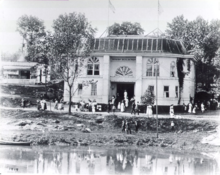|
Henry Morgan Green
Henry Morgan Green (1877–1939) was an American physician, a national healthcare leader,[1] researcher, scholar, real estate investor, and alderman.[2] He served as the city physician in Knoxville, Tennessee, and president of the National Medical Association.[3] He was one of the founders of Knoxville Medical College;[4] and is credited with expanding healthcare coverage for the Black community in Knoxville.[1] Early life and education Henry Morgan Green was born in 1877 in Adairsville, Georgia.[3][5] Green studied at the Normal School at Knoxville College, where he graduated (1895).[3][6] After a year of teaching in Riceville, Tennessee, he returned a year later to Knoxville College to attend the college's newly established medical department.[7][6] Green continued studies at the University of Michigan, and Northwestern University.[when?][3] CareerHe had an early medical practice in Jellico, Tennessee.[8] For 17 years he served as the city physician in Knoxville, Tennessee; and worked as a doctor in Knoxville from 1900 to 1939.[3][4] Green was one of the founders of Knoxville Medical College (1900–1910).[4][9] In 1900, Green became an alderman (or council member) in order to represent his neighborhood in the fifth ward, he was the first Black alderman in the city.[2] He remained an alderman until 1912, and it took another 62 years before the Knoxville city council had another Black alderman.[10][11][12] In 1910 and 1911, Green served as the chairman of the "Colored Department" at the Appalachian Exposition, held in Knoxville.[13] He served as president of the National Medical Association, elected in 1922;[7][14] and was the founding president of the National Hospital Association in 1923.[3][4] In 1922, Green married school teacher Henri Henderson; and together they had two children.[3][8] Death and legacyHe died of pneumonia on March 19, 1939, in Knoxville.[8] He is buried on the campus of Knoxville College, in the Freedmen's Mission Historic Cemetery (formerly known as the Fourth United Presbyterian Church Cemetery).[15] The Green School (sometimes refer to as the "Colored High School" in the early years) in Knoxville was named for him, and opened in 1909.[5][16] Green was profiled in the book, The Knoxville Negro: Emphasizing the Great Era of Progress Prevalent in Negro Knoxville Today (1929) by Bartow G. Wilson.[17] See alsoReferences
|
||||||||||||||||||
